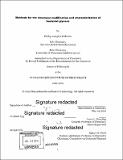Methods for the structural modification and characterization of bacterial glycans
Author(s)
Calabretta, Phillip Joseph.
Download1123218396-MIT.pdf (15.02Mb)
Other Contributors
Massachusetts Institute of Technology. Department of Chemistry.
Advisor
Laura L. Kiessling.
Terms of use
Metadata
Show full item recordAbstract
Despite the importance of carbohydrates in cellular processes, there are few tools for their study in the context of a cell. The finding that non-natural monosaccharides could be internalized, processed, and displayed in cellular glycans in the early 1990s led to the development of metabolic incorporation probes for mammalian and microbial organisms. Taking advantage of the development of rapid, bioorthogonal chemistries these probes have provided valuable insight into intermolecular interactions, biosynthetic and metabolic pathways, and intercellular interactions. The successful application of metabolic incorporation probes to bacteria has been hampered by their unfastidious use of monosaccharides for energy production. In this work, we describe an alternative approach to metabolic incorporation, termed biosynthetic incorporation, using synthetic sugar donors that do not require intracellular processing prior to glycosyl transfer. We evaluated our approach in cells of the suborder Corynebacterianeae, for which no useful probes had been described. Within Corynebacterianeae exist important human pathogens, including Mycobacterium tuberculosis. These bacteria utilize a host of lipid-linked sugar donors to construct polysaccharides implicated in immune avoidance and intrinsic antibiotic resistance. We produced a library of sugar donor analogs that were assessed for processing in cells. The most promising analog was used to evaluate incorporation in Corynebacterium glutamicum and Mycobacterium smegmatis, two widely used models of M. tuberculosis. We found that the sugar donor analog could work within the cell's traditional workflow, so analogs bearing azido-groups were synthesized. Incorporation of the azido-analogs labels nascent cell wall as determined by fluorescence microscopy. We have also begun synthesizing and evaluating probes targeting other polysaccharides within Corynebacterianeae. These findings establish biosynthetic incorporation as a novel mode of polysaccharide structure modification. Furthermore, Biosynthetic incorporation probes offer advantages over metabolic incorporation, including the lack of requisite intracellular processing and the ability to target glycans that were previously recalcitrant to current methods.
Description
Thesis: Ph. D., Massachusetts Institute of Technology, Department of Chemistry, 2019 Cataloged from PDF version of thesis. Page 184 blank. Includes bibliographical references (pages 151-183).
Date issued
2019Department
Massachusetts Institute of Technology. Department of ChemistryPublisher
Massachusetts Institute of Technology
Keywords
Chemistry.